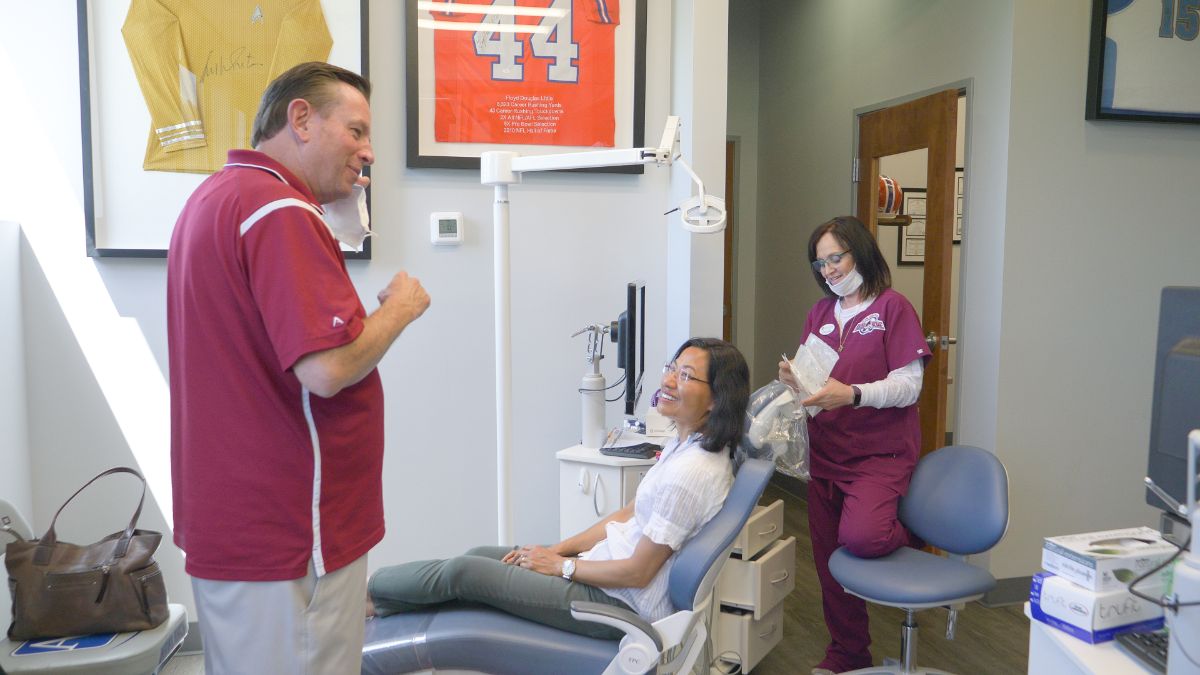It’s not unusual for our team here at Advanced Orthodontics to treat patients experiencing pain or discomfort in their jaw or the surrounding areas. Though there can be several causes for this, one of the most common is temporomandibular joint disorder, or TMD for short.
TMD is a broad term that is used to describe the jaw pain and dysfunction that can happen when something has gone wrong with the muscles and joints of the jaw. Because these are complex and full of nerve endings, even something being slightly off can produce symptoms that range from mild to acute, including pain, swelling, or problems chewing.
If you’ve been experiencing any of the symptoms associated with TMD, you may be wondering what this disorder actually is, and if there are any treatments available for it. We’re going to take a closer look at these questions below, so keep reading for more expert information!
Is TMJ the same thing as TMD?
While many people–and professionals!–use these two abbreviations interchangeably, they’re not actually the same thing. TMJ stands for temporomandibular joint, which is the hinge points that connects our jaw bones to our head. This joint is located directly in front of the ears, and gives us the ability to speak and chew our food. The TMJ is also incredibly mobile, and is able to rotate, glide, and act as a powerful hinge simultaneously.
The TMJ is also surrounded by a number of complex protectors like tendons, muscles, and joint pads. These components normally get along just fine, but if they are thrown off course for any reason, it can result in pain, popping, and inflammation. Enter TMD!
The signs and symptoms of TMD
Because we use our TMJ so often, the range of symptoms associated with TMD can be wide and varied, and every case is different. Some people will only have issues with one side of their face, while others may experience problems with both sides. Some patients have mild symptoms that show up every once in a while, while others struggle with serious problems that can take years to resolve. Some of the most common signs of TMD include:
- pain or tenderness in the face, jaw joint, neck, or shoulders
- pain in or around the ear when chewing or speaking
- difficulty opening the mouth wide
- jaws that get stuck or locked in an open- or closed-mouth position
- popping or other noise in the jaw joint when you open or close your mouth
- popping or other noise in the jaw when chewing
- a “tired” feeling in the face
- difficulty chewing
- feeling as though your upper and lower teeth don’t fit together properly
- swelling on the side of your face
- ringing or stuffy ears
- migraines or headaches
As we mentioned briefly, there are other issues that can cause the symptoms most commonly experienced with TMD, such as tooth decay, gum disease, and even medical conditions like arthritis. That’s why it’s important to receive a proper diagnosis and the appropriate treatment from an experienced orthodontist like Drs. Nielson and White.
What causes TMD?
Injuries to your jaw, TMJ, or the muscles of your head and neck are obvious causes of TMD. Symptoms can also come from any number of problems with the muscles of your jaw, or with the parts of the joint itself. Other factors may contribute as well, such as:
- grinding or clenching your teeth, as this puts extra pressure on the joint
- movement of the soft cushion or disc between the ball and socket of the joint
- arthritis in the TMJ
- stress, which can tighten your facial and jaw muscles, or cause you to clench the teeth
If you have an untreated problem with your bite or a misaligned jaw, it can also put undue stress on the more sensitive parts of your TMJ. This may result in a chronic shooting pain that can be felt in your face, neck, shoulders, back, and arms.
How is TMD diagnosed?
Here at Advanced Orthodontics, we’re able to use the latest in dental and orthodontic technology to pinpoint the source of your TMD. Our doctors use multiple methods to accurately diagnose TMD, including:
- measuring aspects of the teeth and jaw
- determining the jaw’s proper resting position
- mapping the movement of the jaw during speaking and eating
Once our expert team has determined the source of your TMD and given you a proper diagnosis, our doctors will be able to create a customized treatment plan for your unique needs.
How is TMD treated?
Many people who have TMD experience only minor symptoms that appear out of the blue every once in a while. These generally resolve on their own within a few weeks or months, during which symptoms can be eased by:
- eating softer foods
- applying ice or moist heat to the affected area
- avoiding extreme jaw movements like wide yawning
- taking smaller bites of food
- alternating chewing between both sides of your mouth
- exploring gentle stress-relief techniques
Advanced Orthodontics prefers conservative and reversible treatments for TMD whenever possible. Because these are non-invasive, they don’t cause any permanent changes to the structure or position of the jaw or teeth. Even patients with more persistent TMD symptoms won’t need aggressive treatment most of the time.
One example of conservative treatment is a night guard, or occlusal guard. This is a custom-made mouthguards you wear over your teeth to protect them from damage caused by clenching or grinding. Because it creates a physical barrier between your upper and lower teeth, you end up biting against the guard rather than wearing down your own teeth, something that can cause TMD symptoms. Night guards can also help correct the bite by putting teeth in a more desirable position.
If bite correction is needed to minimize or eliminate your TMD symptoms, we may recommend orthodontic treatment like braces or clear aligner therapy with Invisalign.
If TMD is left untreated, it can lead to inflammation, swelling, or chronic pain. It can also contribute to progressive dental problems, such as premature tooth wear and periodontal disease. If you’ve been experiencing any symptoms of TMD, we encourage you to get in touch with our office to schedule a thorough examination with Dr. Nielson or Dr. White!
Treat your TMD with expert care from Advanced Orthodontics
Have you been struggling with symptoms of TMD yourself? Perhaps you suspect it in a loved one? Whatever your reason for wanting to know more about TMD diagnosis and treatment, we invite you to reach out to our team today for a FREE consultation. When it comes to providing high-quality orthodontic care in Aurora, Advanced Orthodontics simply can’t be beat!




